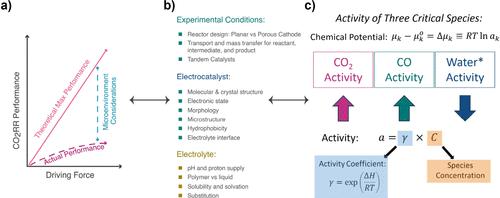当前位置:
X-MOL 学术
›
Acc. Mater. Res.
›
论文详情
Our official English website, www.x-mol.net, welcomes your
feedback! (Note: you will need to create a separate account there.)
The Microenvironment Frontier for Electrochemical CO2 Conversion
Accounts of Materials Research ( IF 14.0 ) Pub Date : 2024-10-30 , DOI: 10.1021/accountsmr.4c00294 Andrew B. Wong
Accounts of Materials Research ( IF 14.0 ) Pub Date : 2024-10-30 , DOI: 10.1021/accountsmr.4c00294 Andrew B. Wong

|
low CO2 solubility in aqueous conditions the delicate balance between the delivery of essential proton donors for CO2RR versus the strong tendency to convert donated protons to H2 via the competing hydrogen evolution reaction (HER) the delicate balance between reaction pathways toward multiple CO2RR products dynamic changes in local pH, ion concentrations, hydrophobicity, and active sites in response to phenomena such as carbonate formation and restructuring of electrocatalysts Figure 1. Schematic overview of CO2RR microenvironment effects. (a) Microenvironment impact on CO2RR performance. (b) Microenvironment considerations: experimental conditions, electrocatalyst characteristics, and electrolyte characteristics. (c) Description of the activity and activity coefficient for CO2, CO, and H2O (or other proton donors). Activity is the lens through which to understand numerous phenomena within the CO2RR microenvironment Figure 2. Schematic overview for macroscale, microscale, and nanoscale effects on planar (a–c) and porous (d–f) electrodes. First, the activity coefficient and concentration terms offer a helpful parameter space to compare the effects of various interventions and adjustments to the microenvironment that had previously been difficult to compare based on objective measures (Figure 1b). Second, this approach highlights the importance of improving our understanding of the relative contributions of three-phase (gas–liquid–solid) and larger area two-phase (liquid–solid) interfaces on CO2RR, which has attracted recent attention. (12,13) Third, this understanding highlights the importance of developing new in situ and in operando analytical techniques to probe the local distributions of CO2, CO, and H2O under reaction conditions. Attenuated total reflectance surface-enhanced infrared absorption spectroscopy (ATR-SEIRAS) has already shown promise for quantifying bound versus free water during CO2RR. (13) What are strategies to extend recent fundamental developments on controlling water activity to improve CO2RR performance at high current densities? How can we use the microenvironment to explore electrochemical strategies to simultaneously accomplish CO2 capture and conversion? Based on the historical development of CO2RR approaches, can we or should we adopt new materials for CO2RR GDLs and ionomers (typically materials developed for other chemical transformations with different requirements) to specialize in CO2RR’s requirements? In CO2RR, what is the structure of the three-phase gas–liquid–solid and other interfaces under reaction conditions? Leveraging the microenvironment, how can CO2 be used to make higher-value products or products that can integrate into the economy to achieve net negative CO2 emissions? What can new CO2RR systems look like? Moreover, can we reimagine our strategies to valorize CO2? Are there advantages to performing CO2RR electrochemistry at high temperatures or high pressures? To what extent can we leverage the enzymatic microenvironment of living systems to achieve electrochemical CO2 conversion to high-value products beyond C3+? Andrew B. Wong is an Assistant Professor in the Department of Materials Science and Engineering at the National University of Singapore. Prior to his independent career, he was a postdoctoral researcher at Stanford University, where he was coadvised by Thomas Jaramillo and James Harris. He received his Ph.D. in Chemistry from UC Berkeley in 2016 under Peidong Yang and received his joint B.S.–M.S. degree in Chemistry at the University of Chicago in 2011. The A.B. Wong Group focuses on understanding and developing control of the microenvironment for electrochemical CO2 conversion and exploring emerging strategies to valorize CO2. A.B.W. would like to acknowledge startup funds from the National University of Singapore through the Presidential Young Professorship early career award (WBS: A-0009245-05-00). Ongoing efforts on bioelectrochemical CO2 conversion are financially supported by the Competitive Research Programme of the National Research Foundation Singapore (NRF-CRP27-2021-0004). This article references 14 other publications. This article has not yet been cited by other publications.
中文翻译:

电化学 CO2 转化的微环境前沿
在水性条件下的低 CO2 溶解度 CO2RR 必需质子供体的输送与通过竞争性析氢反应 (HER) 将供体转化为 H2 的强烈趋势之间的微妙平衡 指向多个 CO2RR 产物的反应途径之间的微妙平衡 局部 pH 值的动态变化, 离子浓度、疏水性和活性位点对碳酸盐形成和电催化剂重组等现象的响应图 1.CO2RR 微环境效应的示意图概述。(a) 微环境对 CO2RR 性能的影响。(b) 微环境考虑:实验条件、电催化剂特性和电解质特性。(c) CO2、CO 和 H2O(或其他质子供体)的活性和活性系数的描述。活动是了解 CO2RR 微环境中众多现象的镜头 图 2.宏观、微观和纳米尺度对平面 (a-c) 和多孔 (d-f) 电极的影响示意图概述。首先,活性系数和浓度项提供了一个有用的参数空间,用于比较各种干预措施和调整对微环境的影响,而这些效果以前很难根据客观测量进行比较(图 1b)。其次,这种方法强调了提高我们对三相(气-液-固)和更大面积的两相(液-固)界面对 CO2RR 的相对贡献的理解的重要性,这引起了最近的关注。 (12,13) 第三,这种理解强调了开发新的原位和原位分析技术以探测反应条件下 CO2、CO 和 H2O 的局部分布的重要性。衰减全反射表面增强红外吸收光谱 (ATR-SEIRAS) 已经显示出在 CO2RR 期间量化结合水与游离水的前景。(13) 有哪些策略可以扩展控制水活动的最新基本进展,以提高高电流密度下的 CO2RR 性能?我们如何利用微环境来探索电化学策略,同时完成 CO2 捕获和转化?根据 CO2RR 方法的历史发展,我们是否可以或应该为 CO2RR GDL 和离聚物采用新材料(通常是为具有不同要求的其他化学转化开发的材料)来专门满足 CO2RR 的要求?在 CO2RR 中,反应条件下三相气-液-固和其他界面的结构是什么?利用微环境,如何利用 CO2 制造更高价值的产品或可以融入经济的产品,以实现 CO2 净负排放?新的 CO2RR 系统是什么样的?此外,我们能否重新构想我们评估 CO2 的策略?在高温或高压下进行 CO2RR 电化学分析有什么优势吗?我们可以在多大程度上利用生命系统的酶微环境来实现电化学 CO2 转化为 C3+ 以外的高价值产品? Andrew B. Wong 是新加坡国立大学材料科学与工程系的助理教授。在独立职业生涯之前,他是斯坦福大学的博士后研究员,在那里他得到了 Thomas Jaramillo 和 James Harris 的共同顾问。他于 2016 年在加州大学伯克利分校获得化学博士学位,师从杨培东,并于 2011 年在芝加哥大学获得化学学士和硕士学位。A.B. Wong 集团专注于了解和开发对电化学 CO2 转化微环境的控制,并探索评估 CO2 的新兴策略。A.B.W. 通过总统青年教授早期职业奖 (WBS: A-0009245-05-00) 感谢新加坡国立大学的启动资金。新加坡国家研究基金会竞争研究计划 (NRF-CRP27-2021-0004) 为生物电化学 CO2 转化的持续努力提供了财政支持。本文引用了其他 14 种出版物。本文尚未被其他出版物引用。
更新日期:2024-10-30
中文翻译:

电化学 CO2 转化的微环境前沿
在水性条件下的低 CO2 溶解度 CO2RR 必需质子供体的输送与通过竞争性析氢反应 (HER) 将供体转化为 H2 的强烈趋势之间的微妙平衡 指向多个 CO2RR 产物的反应途径之间的微妙平衡 局部 pH 值的动态变化, 离子浓度、疏水性和活性位点对碳酸盐形成和电催化剂重组等现象的响应图 1.CO2RR 微环境效应的示意图概述。(a) 微环境对 CO2RR 性能的影响。(b) 微环境考虑:实验条件、电催化剂特性和电解质特性。(c) CO2、CO 和 H2O(或其他质子供体)的活性和活性系数的描述。活动是了解 CO2RR 微环境中众多现象的镜头 图 2.宏观、微观和纳米尺度对平面 (a-c) 和多孔 (d-f) 电极的影响示意图概述。首先,活性系数和浓度项提供了一个有用的参数空间,用于比较各种干预措施和调整对微环境的影响,而这些效果以前很难根据客观测量进行比较(图 1b)。其次,这种方法强调了提高我们对三相(气-液-固)和更大面积的两相(液-固)界面对 CO2RR 的相对贡献的理解的重要性,这引起了最近的关注。 (12,13) 第三,这种理解强调了开发新的原位和原位分析技术以探测反应条件下 CO2、CO 和 H2O 的局部分布的重要性。衰减全反射表面增强红外吸收光谱 (ATR-SEIRAS) 已经显示出在 CO2RR 期间量化结合水与游离水的前景。(13) 有哪些策略可以扩展控制水活动的最新基本进展,以提高高电流密度下的 CO2RR 性能?我们如何利用微环境来探索电化学策略,同时完成 CO2 捕获和转化?根据 CO2RR 方法的历史发展,我们是否可以或应该为 CO2RR GDL 和离聚物采用新材料(通常是为具有不同要求的其他化学转化开发的材料)来专门满足 CO2RR 的要求?在 CO2RR 中,反应条件下三相气-液-固和其他界面的结构是什么?利用微环境,如何利用 CO2 制造更高价值的产品或可以融入经济的产品,以实现 CO2 净负排放?新的 CO2RR 系统是什么样的?此外,我们能否重新构想我们评估 CO2 的策略?在高温或高压下进行 CO2RR 电化学分析有什么优势吗?我们可以在多大程度上利用生命系统的酶微环境来实现电化学 CO2 转化为 C3+ 以外的高价值产品? Andrew B. Wong 是新加坡国立大学材料科学与工程系的助理教授。在独立职业生涯之前,他是斯坦福大学的博士后研究员,在那里他得到了 Thomas Jaramillo 和 James Harris 的共同顾问。他于 2016 年在加州大学伯克利分校获得化学博士学位,师从杨培东,并于 2011 年在芝加哥大学获得化学学士和硕士学位。A.B. Wong 集团专注于了解和开发对电化学 CO2 转化微环境的控制,并探索评估 CO2 的新兴策略。A.B.W. 通过总统青年教授早期职业奖 (WBS: A-0009245-05-00) 感谢新加坡国立大学的启动资金。新加坡国家研究基金会竞争研究计划 (NRF-CRP27-2021-0004) 为生物电化学 CO2 转化的持续努力提供了财政支持。本文引用了其他 14 种出版物。本文尚未被其他出版物引用。


















































 京公网安备 11010802027423号
京公网安备 11010802027423号